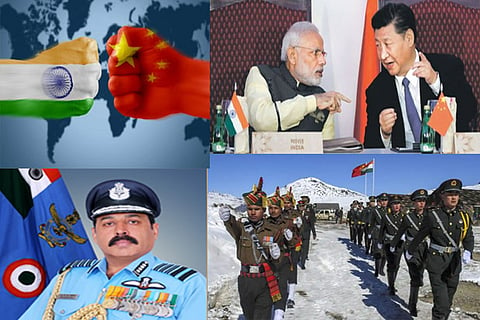

Chennai
Members of the Opposition have been goading Prime Minister Narendra Modi to dole out a befitting reply to China, for its alleged incursion into Indian territory. In the backdrop of these developments, the Chief of the Indian Air Force, Air Chief Marshal RKS Bhadauria, went on record to say that although the nation is not expecting to draw the battle lines with its neighbour yet, India is fully battle-ready, if the situation demands, and in a position to address any contingency that arises.
This statement brings the much needed reassurance to all those who see China as a predator. But a deeper analysis into where this confidence comes from, reveals that India not just has the nuclear capability, but a few more aces up its sleeve. Firstly, India has the firepower - courtesy of the Air Force. The nation boasts of a cache of 270 fighters, and 68 ground attack aircraft that can be employed in case of a military engagement with China. To supplement this, the nation also has built airbases close to the Chinese border. The Chinese, on the other hand, has about 157 fighters and a fleet of ground attack drones in this area. Where the IAF scores over China’s PLA is in areas of infrastructural support, command, control and communication mechanisms as well as enhanced air defence capabilities. A new study by Belfer Center at Harvard Kennedy School of Government in Boston and the Center for a New American Security in Washington present evidence of India being a veritable David lying in wait for the Goliath of China, at least in the context of such mountainous terrain. But that’s not all. The real differentiator is India’s human capital and its collective experience, which can prove to be a game-changer when it comes to aerial and ground combat. Hardened by a series of low-intensity conflicts with its other neighbour Pakistan, both the Indian Army and Air Force can boast of cutting their teeth with co-ordinated combat on land and in the air. The Chinese PLA’s last ground combat experience was limited to its skirmishes with Vietnam in 1979.
However, these advantages can in no way undermine the Chinese military capabilities, as the Asian superpower has a defence budget allocation that is four times as much as India’s. And Beijing is on a continuous overdrive to modernise its military. It is clear that a full-blown conflict between the two countries could spell catastrophe, in spite of both nations being signatories to the ‘No first use’ policy vis-a-vis nuclear weapons. Experts believe that the Chinese administration is falling back on an often-used trope - a diversionary tactic of sorts when the world’s complete attention has been taken up by the pandemic, whose origin has been zeroed in on China. It would be wise for both India and China to resolve this dispute through dialogue, especially at a time such as this in history, when both nations, need to look beyond border control and focus on the common, invisible enemy.
Visit news.dtnext.in to explore our interactive epaper!
Download the DT Next app for more exciting features!
Click here for iOS
Click here for Android